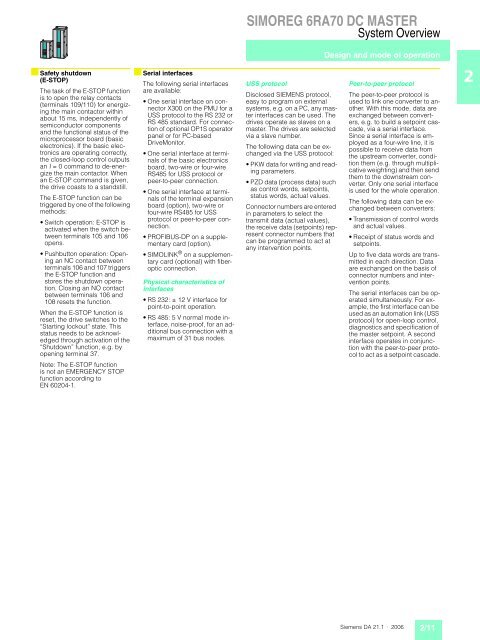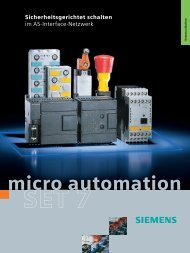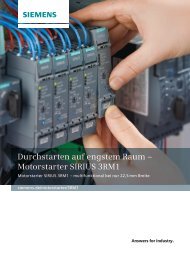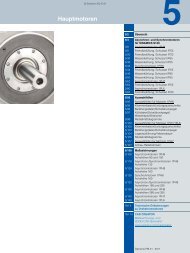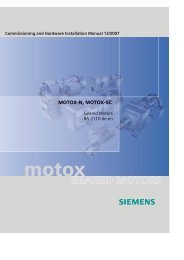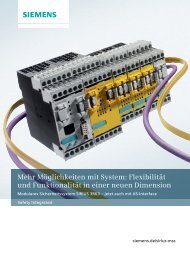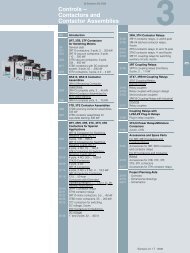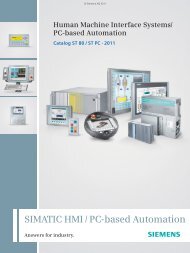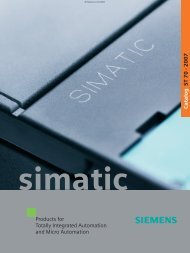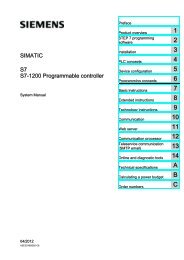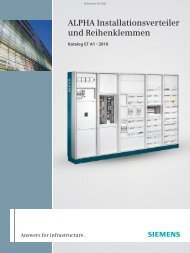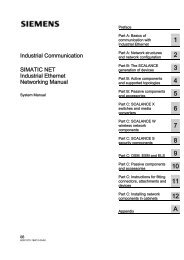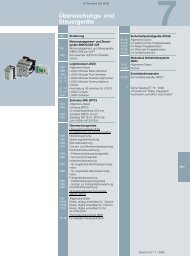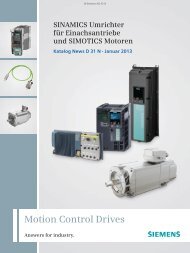simoreg 6ra70 dc master
simoreg 6ra70 dc master
simoreg 6ra70 dc master
You also want an ePaper? Increase the reach of your titles
YUMPU automatically turns print PDFs into web optimized ePapers that Google loves.
■ Safety shutdown<br />
(E-STOP)<br />
The task of the E-STOP function<br />
is to open the relay contacts<br />
(terminals 109/110) for energizing<br />
the main contactor within<br />
about 15 ms, independently of<br />
semiconductor components<br />
and the functional status of the<br />
microprocessor board (basic<br />
electronics). If the basic electronics<br />
are operating correctly,<br />
the closed-loop control outputs<br />
an I = 0 command to de-energize<br />
the main contactor. When<br />
an E-STOP command is given,<br />
the drive coasts to a standstill.<br />
The E-STOP function can be<br />
triggered by one of the following<br />
methods:<br />
Switch operation: E-STOP is<br />
activated when the switch between<br />
terminals 105 and 106<br />
opens.<br />
Pushbutton operation: Opening<br />
an NC contact between<br />
terminals 106 and 107 triggers<br />
the E-STOP function and<br />
stores the shutdown operation.<br />
Closing an NO contact<br />
between terminals 106 and<br />
108 resets the function.<br />
When the E-STOP function is<br />
reset, the drive switches to the<br />
“Starting lockout” state. This<br />
status needs to be acknowledged<br />
through activation of the<br />
“Shutdown” function, e.g. by<br />
opening terminal 37.<br />
Note: The E-STOP function<br />
is not an EMERGENCY STOP<br />
function according to<br />
EN 60204-1.<br />
■ Serial interfaces<br />
The following serial interfaces<br />
are available:<br />
One serial interface on connector<br />
X300 on the PMU for a<br />
USS protocol to the RS 232 or<br />
RS 485 standard. For connection<br />
of optional OP1S operator<br />
panel or for PC-based<br />
DriveMonitor.<br />
One serial interface at terminals<br />
of the basic electronics<br />
board, two-wire or four-wire<br />
RS485 for USS protocol or<br />
peer-to-peer connection.<br />
One serial interface at terminals<br />
of the terminal expansion<br />
board (option), two-wire or<br />
four-wire RS485 for USS<br />
protocol or peer-to-peer connection.<br />
PROFIBUS-DP on a supplementary<br />
card (option).<br />
SIMOLINK ® on a supplementary<br />
card (optional) with fiberoptic<br />
connection.<br />
Physical characteristics of<br />
interfaces<br />
RS 232: ± 12 V interface for<br />
point-to-point operation.<br />
RS 485: 5 V normal mode interface,<br />
noise-proof, for an additional<br />
bus connection with a<br />
maximum of 31 bus nodes.<br />
SIMOREG 6RA70 DC MASTER<br />
System Overview<br />
USS protocol<br />
Disclosed SIEMENS protocol,<br />
easy to program on external<br />
systems, e.g. on a PC, any <strong>master</strong><br />
interfaces can be used. The<br />
drives operate as slaves on a<br />
<strong>master</strong>. The drives are selected<br />
via a slave number.<br />
The following data can be exchanged<br />
via the USS protocol:<br />
PKW data for writing and reading<br />
parameters.<br />
PZD data (process data) such<br />
as control words, setpoints,<br />
status words, actual values.<br />
Connector numbers are entered<br />
in parameters to select the<br />
transmit data (actual values),<br />
the receive data (setpoints) represent<br />
connector numbers that<br />
can be programmed to act at<br />
any intervention points.<br />
Design and mode of operation<br />
Peer-to-peer protocol<br />
The peer-to-peer protocol is<br />
used to link one converter to another.<br />
With this mode, data are<br />
exchanged between converters,<br />
e.g. to build a setpoint cascade,<br />
via a serial interface.<br />
Since a serial interface is employed<br />
as a four-wire line, it is<br />
possible to receive data from<br />
the upstream converter, condition<br />
them (e.g. through multiplicative<br />
weighting) and then send<br />
them to the downstream converter.<br />
Only one serial interface<br />
is used for the whole operation.<br />
The following data can be exchanged<br />
between converters:<br />
Transmission of control words<br />
and actual values.<br />
Receipt of status words and<br />
setpoints.<br />
Up to five data words are transmitted<br />
in each direction. Data<br />
are exchanged on the basis of<br />
connector numbers and intervention<br />
points.<br />
The serial interfaces can be operated<br />
simultaneously. For example,<br />
the first interface can be<br />
used as an automation link (USS<br />
protocol) for open-loop control,<br />
diagnostics and specification of<br />
the <strong>master</strong> setpoint. A second<br />
interface operates in conjunction<br />
with the peer-to-peer protocol<br />
to act as a setpoint cascade.<br />
Siemens DA 21.1 · 2006 2/11<br />
2


